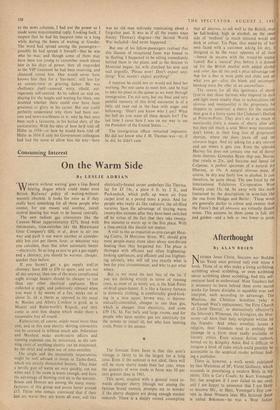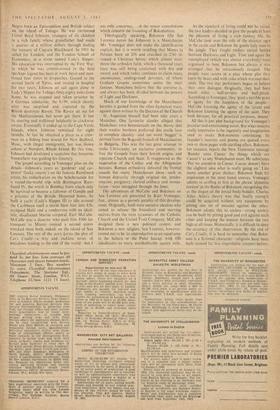Afterthought
By ALAN BRIEN
NEITHER Jesus Christ, Socrates nor Buddha (as Yeats. once pointed out) ever wrote a book. Those of us who make a living scribbling, scribbling about scribbling, or even scribbling about scribbling about scribbling, find this self- restraint hard to understand. Most Teachers feel it necessary to leave behind them some sacred works for future disciples to squabble over and interpret, each according to advantage. The Muslims, the Christian Scientists (why is Nathanael West's replacement, 'the First Church of Christ Dentist,' so destructively effective?), the Jehovah's Witnesses, the Irvingites, the Mor- mons—all have their holy scriptures written by the -founder. And when novelists invent a religion, their founders tend to embody the message in a form most easily available to literary critics. Even science fiction authors, hotted on by Kingsley Amis, find it difficult to imagine a book of rules which could possibly be acceptable to the sceptical reader without find- ing a publisher.
There is, however, a work newly published by that Maecenas of SF, Victor Gollancz, which succeeds in postulating a modern Bible in hip terms. This is Cat's Cradle, by Kurt Vonnegut, Jnr. (an anagram if I ever failed to see one), and I am happy to announce that I am likely to become Mr., or Herr, Vonnegut's first con- vert in these Western isles. His fictional Soter is called Bokonon—he was a West Indian
Negro born an Episcopalian and British subject
r on the . island • of Tobago. He was christened Lionel Boyd Johnson, youngest of six children
in a rich family whose grandfather had made a quarter of a million dollars through finding the treasure of Captain Blackbeard. In 1411 he sailed for London, and the London School of Economics, in a sloop named Lady's Slipper: His education was interrupted by the First War, in which he was commissioned in the field (perhaps legend has been at work here) and men- tioned four times in despatches. Gassed in the second battle of Ypres, and treated in hospital for two years, Johnson set sail again alone in Lady's Slipper for Tobago. Only.eighty miles from home, he was stopped and taken prisoner by a German submarine, the U49, which shortly after was surprised and captured by the British destroyer Raven. The Raven set out for the Mediterranean, but never got there. It lost its steering and Wallowed helplessly in clockwise circles. Eventually it ended up in the Cape Verde Islands, where Johnson remained for eight months. At last he obtained a place as a crew- man on a fishing boat bound for New Bedford, Mass., with illegal immigrants, but was blown ashore at Newport, Rhode Island. By this time.
Johnson had developed a suspicion that Someone Somewhere was guiding his itinerary.
The gospel according to Vonnegut piles on the details-- Johnson's years as 'gardener and car- penter' (lucky omens!) on the famous Rumfoord estate, his embarkation on the Scheherazade for
. a round-the-world trip with Remington Rum- foord IV, the wreck in Bombay from which only he survived, to become a follower of Gandhi and a prisoner of the British. Deported home, he built a yacht (Lady's Slipper 1.1) to idle around
the Caribbean until a storm blew him into US- occopied Haiti and a rendezvous with an ideal- istic, disaffected Marine corporal. Earl McCabe. McCabe was a deserter who paid him $500 for transport to Miami- -instead a second storm wrecked them both, naked, on the island of San
Lorenzo. The rest of the story torms the plot of Cat's Crain(' a wry and reckless series of
anecdotes leading to the end of the world but I am only concerneL. ;h the minor convolutions
.Nvhich concern the founding. of Bokononism.
Theologically speaking, Bokonon (the San Lorenzo patois for Johnson) is a Manichaean.
Mr. Vonnegut does not make the identification explicit, but it is worth recalling that Manes (a Persian born AD 216 and crucified in 276) in-
vented a Christian heresy which almost over- threw the orthodox faith, which a thousand years later was still being cauterised with fire and sword, and which today continues to claim many unconscious, underground devotees, -of whom Graham Greene sometimes seems the most famous. Manichees believe that the universe is, and always has been, divided between the powers of Light and Darkness.
Much of our knowledge of the Manichaean heretics is gained from the often hysterical tracts against them written by the Doctors of the Church
Si. Augustine himself had been nine years a Manichee. One favourite slander alleged that Manichees were homosexuals on the theory that their weaker brethren preferred this sterile love to complete chastity—and our word 'bugger' is derived from the Bogomil branch of Manichaeism in Bulgaria. This was the last great attempt to make Christianity an exclusive community, to free the Gospels from their Jewish origins and separate Church and State. It reappeared as the inspiration of the Cathar and the Albigensian heresies. Roman orthodoxy defeated the frontal assault but many Manichaean ideas-,such as human depravity through original sin, predes- tination. purgatory, clerical celibacy and monas- ticism were smuggled through the lines.
The adventures of McCabe and Bokonon on San Lorenzo are presented by Kurt Vonnegut, Jun., almost as a parody parable of thiS develop- ment. Originally, both were socialist idealists who aimed to release the brutalised and starving. natives from the twin tyrannies of the Catholic Church and the United Fruit Company. McCabe designed them a new political system, and Bokonon a new religion. San Lorenzo, however, turned out to be 'as unproductive as an equal area in the Sahara or the Polar Icecap' with 450 inhabitants to every uninhabitable square Mile.
As the standard of living could not be raised,
the two leaders decided to give the people at least the pleasure of living a rich fantasy life. So McCabe took over the role of the dictator ogre in the castle and Bokonon the gentle holy man in the jungle. They fought endless unreal battles between Darkness and Light. Time and again the- unemployed (which was almost everybody) were organised to hunt Bokonon but always it was
arranged -that he miraculously escaped. The people were actors in a play whose plot they kuew by heart and with roles which warmed their souls. The two star performers began to believe their own dialogue. Originally, they had been much alike -- half-saviour and half-pirate. According to Vonnegut, they 'paid a terrible price in agony for the happiness of the people-- McCabe knowing the agony of the tyrant and Bokonon knowing the agony of the saint. They both became, for all practical purposes, insane.'
All this is just plot background for Vonnegut's peculiar and entertaining novel. But what remains really impressive is the ingenuity and imagination used to smake Bokononism convincing. Its founder's maxims and poems are quoted every two OF three pages with startling effect. Bokonon. for instance, rejects the New Testament message 'Render unto Caesar the things which are Caesar's' as any Manichaean must. He substitutes 'Pay no attention to Caesar. Caesar doesn't have the slightest idea what is really going on.' Like many another great thinker, Bokonon finds his inspiration in the most banal sources. Vonnegut admits to scoffing at first at the phrase `,dynamic tension' in the Books of Bokonon, recognising this as the slogan of the postal body-builder, Charles Atlas. Atlas's theory was that bodily strength could be acquired without any equipment by pitting one set of muscles against the other. Bokonon adapts this to society—strong society can be built by pitting good and evil against each other and keeping the tension between the two high at all times. Historically, it is difficult to deny the accuracy of this observation. By the end of Cat's (-radii,. it is hard to remember that Boko- non is a fictional character—religions have been built around far less improbable creators before.































 Previous page
Previous page